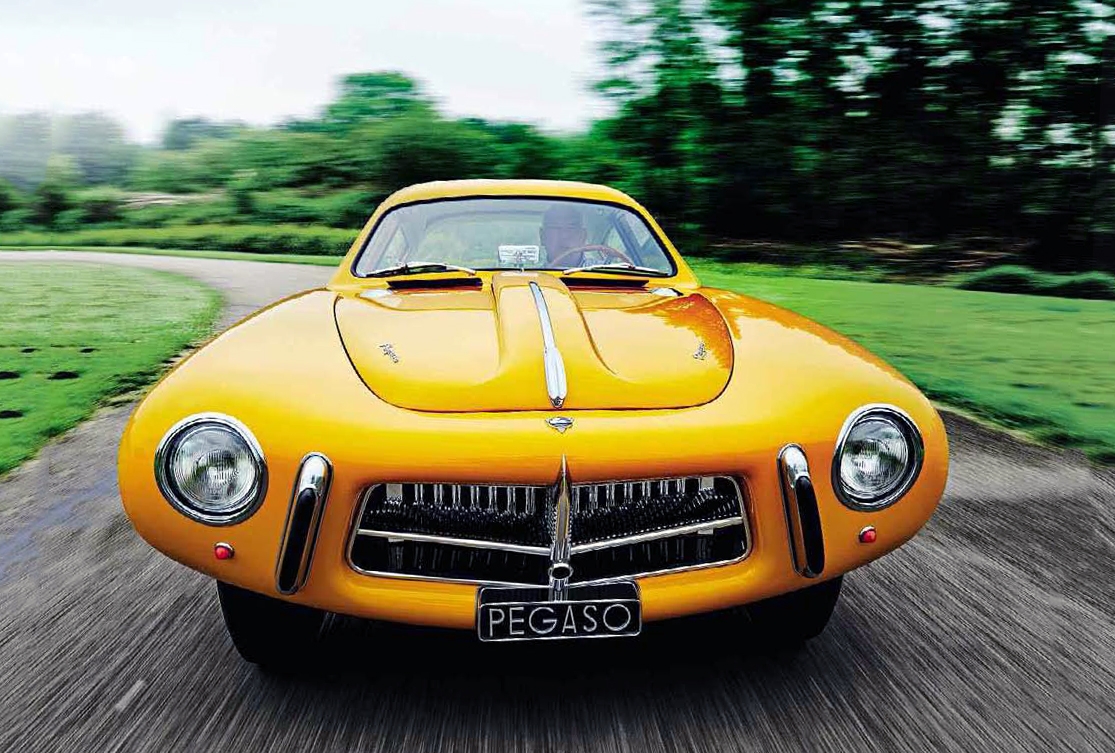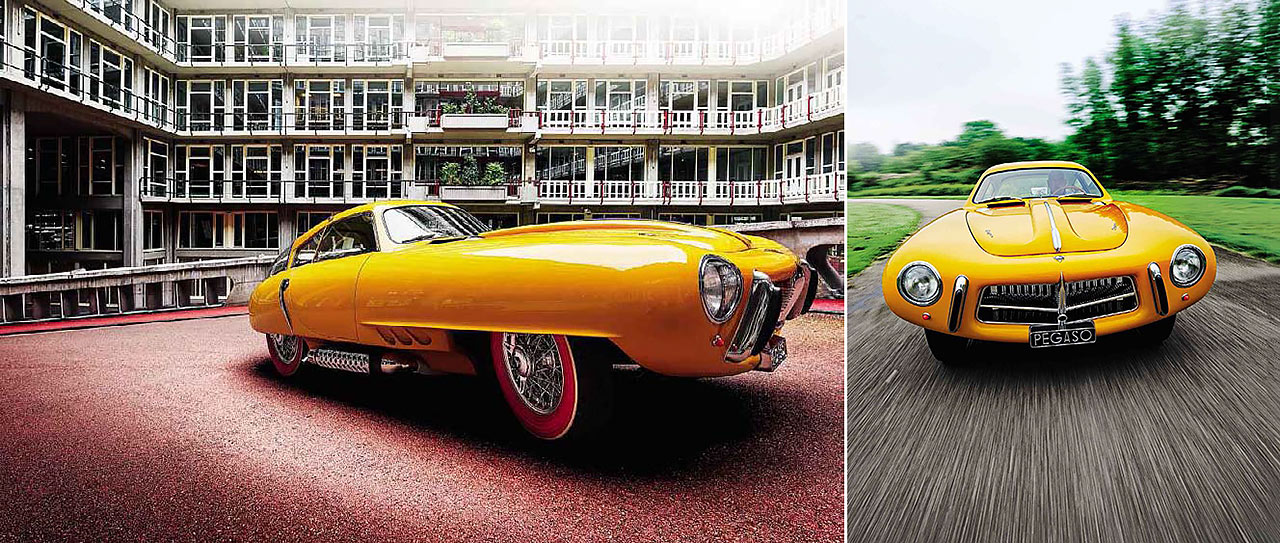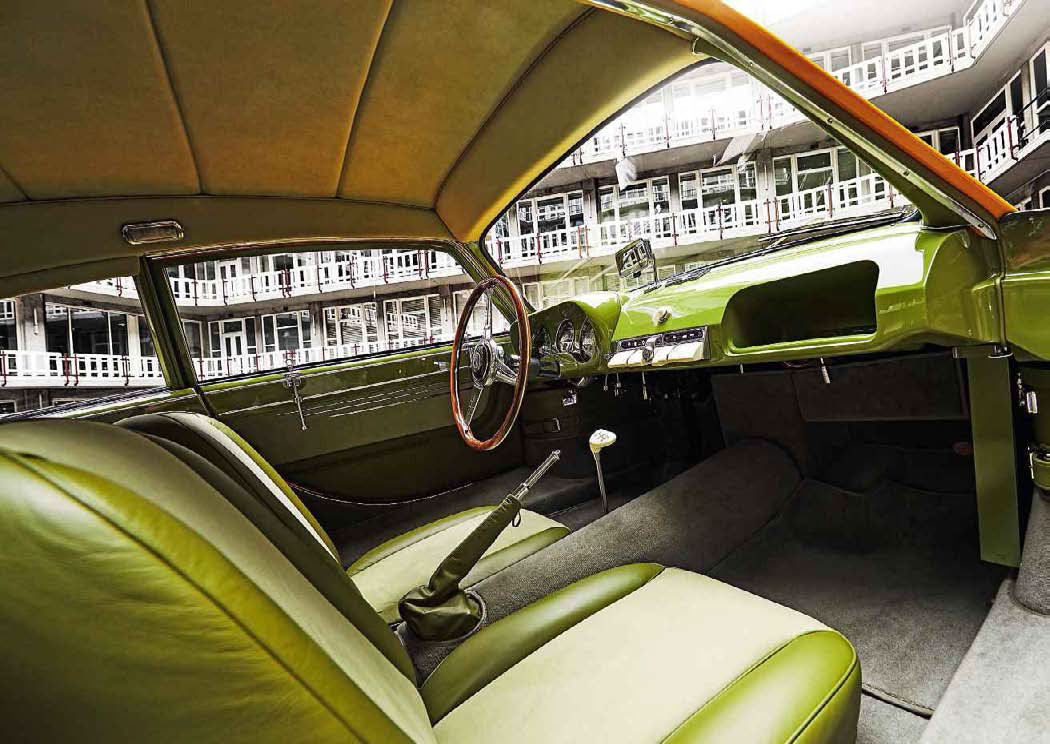
A Space Oddity Pegaso Z-102 First drive of surreal Spanish supercoupé. Driving the wild Pegaso Z-102. The one-off 1952 Pegaso Z-102 Berlineta ENASA Cúpula looks like a spaceship yet was built by a company more used to making trucks. Octane was allowed an exclusive drive – or should that be flight? Words Martin van der Zeeuw. Photography David de Jong.
The keys are in my pocket, but I don’t feel the urge to get behind the wheel and drive off. Not yet. I just gaze at it in awe, like a little boy who is seeing a real fighter jet or a fire engine for the first time. My eyes slowly follow every line, every detail. My brain is trying to reconcile the logic of a traditional motor car with the unpredictability of this bright-yellow phenomenon’s design.

1952 Pegaso Z-102 Berlineta ENASA Cúpula road test
Is it beautiful? Yes, it is. And no, it isn’t. But it is definitely breathtaking. Who on earth penned this 1952 Pegaso Z-102 Berlineta ENASA Cúpula (yes, Berlineta with one ‘t’ – it’s Spanish). Pablo Picasso? Henry Moore? Was it made on Earth at all?
In fact, the exaggeratedly curved lines of this Plexiglas-domed yellow spaceship with its ‘redwall’ landing gear, all seemingly inspired by 1950s UFO hype, were drawn at a factory. Even more shocking: it was a factory that made trucks and buses.
The Spanish ENASA (Empresa Nacional de Autocamiones SA) was formed in 1945 when Hispano- Suiza was nationalised. ENASA was led by the Spanish industrial engineer Wilfredo Ricart, who came from Alfa Romeo. The Barcelona-based company manufactured trucks, buses and military vehicles under the Pegaso brand, named after Pegasus, the winged horse in Greek mythology. To boost its prestige, ENASA introduced a sports car, the Pegaso Z-102, in 1951 – the Government was backing the company financially and Spain wanted to prove that it still counted as a nation in post-war Europe.
For the same reason, Pegaso’s new sports cars were usually fitted with dramatic coachwork by famous coachbuilders such as Touring and Saoutchik. You wouldn’t be blamed for supposing that the Berlineta Cúpula has a Touring Superleggera feel to it and, while there is some truth behind that, the story is confusing and sometimes even unresolved.
Photographer David de Jong reminds me that we have work to do. I press down the large chrome ball next to the driver’s door, after which the door pops out slightly for it to be opened. Sitting in the light green interior, I feel lowdown but quite comfortable. The dash looks conventional, even slightly Italian, but it’s the only conventional thing about the cockpit. Vanity boxes are fitted left and right below the dashboard and there’s a metal toolbox near the passenger footwell.

1952 Pegaso Z-102 Berlineta ENASA Cúpula road test
Opening the door window presents a challenge. Instead of a handle, two thin vertical rods are connected to the glass and these have to be clicked out of small holders, then moved horizontally and pushed outwards to open the window. Who ever dreamed up that?
A more immediate problem is finding the starter button. ‘It’s the left one,’ says Ron van Dongen, chief engineer at the Louwman Museum, pointing at ten ivorycoloured piano keys on the dash. Trusting him, I turn the ignition key and press the button, after which a sudden loud bang scares the hell out of me. But somehow I must have done the right thing because there’s now a hoarse and uncivilised but roughly consistent engine sound.
Despite the Pegaso being a left-hooker, the dogleg five-speed gearbox works the other way round: first gear and reverse are off to the right, while four and five are on the left. For someone brought up on the Continent, it’s like driving a right-hand-drive car with a manual ’box. To achieve better balance and stability the Pegaso has a rear transaxle, with the gearbox behind the differential.
Getting the car into gear isn’t easy, however, not least because the ’box doesn’t have synchromesh. First gear engages OK, but the golf-club-like lever doesn’t want to move into second, and double-declutching doesn’t work either. My ego flies out of the window – there must be another way.
First, let’s see if we can solve the design mystery. When Pegaso started producing sports cars, there was a close cooperation between Wilfredo Ricart and Carrozzeria Touring’s CEO and chief designer Carlo ‘CiCi’ Bianchi Anderloni. The 1952 Pegaso brochures show artist’s impressions by Touring’s designer Federico Formenti of cars that resembled the Cúpula but were never manufactured. Formenti also designed the equally UFO-inspired Disco Volante by Alfa Romeo, incidentally.

1952 Pegaso Z-102 Berlineta ENASA Cúpula interior. Clockwise from above. Wild enough interior for you? Logo is based on Pegasus, the winged stallion of Greek mythology; vanity boxes and tool case tucked into door pillars.
One of the joint projects between Pegaso and Touring was the ‘Thrill’ Berlinetta (two ‘t’s), also designed in 1952 and presented a year later. The Thrill and the Cúpula could easily be from the same family and there are two unproven theories about this. One is that the Thrill project was executed by Touring and that the Cúpula design was left to ENASA as a work experience project.
The second is that the sketches of the Thrill were left at Pegaso after one of Anderloni’s visits and were used as a starting point for the Cúpula’s design. Neither theory is particularly credible but there must have been some sort of mutual inspiration.
The most reliable conclusion is probably that the Berlineta ENASA Cúpula was a Touring-inspired design by Formenti, with a Touring-inspired type of body construction as well, based on a tubular chassis. Astonishingly, however, the Cúpula’s body is made of steel rather than aluminium, apart from the bonnet.
The origin of its design is not the only myth surrounding the Cúpula. It is said that there was a second Cúpula – or rather a ‘first’. This car, painted cream and with a light green interior, was presented at the 1952 Paris motor show and in London shortly afterwards. It differed from the yellow one in having the door-opening buttons positioned higher and the rear dome lower down. The most credible suggestion is that this car was a prototype that was partly or completely scrapped after the show and/or was used as the basis of the yellow Cúpula, which made its debut at the World Motor Show in New York in February 1953. Therefore this car can be regarded as the only Berlineta Cúpula ever built.
‘You have to consider this as being a freshly delivered, new car that still has to be run in. The mechanics of the gearlever and connecting rods are a bit too tight and we still need to loosen them up,’ says Ron van Dongen. So I give it another go, following his instructions, and it works. Welcome back, ego!
Now I am able to feel the power of the Pegaso as it rapidly accelerates, still boasting that raw sound of its 2.8-litre, 250bhp desmodromic 32-valve V8 – it had a supercharger back in 1953, but that was experimental. The clutch is heavy, the steering is heavy, the gearchanges are heavy; this is a really tough car to drive. The experience is greatly at odds with the Pegaso’s elegant looks, despite the sporty exhaust pipes mounted on each side. Would you believe that the later 3.2-litre Pegaso Z-102 was the fastest production car on the planet in its day? Even faster than a Ferrari? Apparently so.
Since I’m driving on a circuit-like private road in the grounds of the Louwman company – actually the Dutch Toyota and Lexus importer – where the Louwman Museum also used to be before it moved to The Hague in 2010, there is some room to play. The car’s handling feels very tricky, to put it mildly: even trickier than a Porsche in that the rear doesn’t break away but simply jumps out, not helped by the narrowness of the track. The suspension can be adjusted but it’s clear that driving this car quickly demands a lot of skill.

Above and facing page Back to the future, 1953-style: almost nothing about the Pegaso is conventional, including its colour.
Although the Pegaso sports cars were very fast, they never really succeeded in competition. Worth mentioning, however, is that in 1953 a Pegaso broke the speed record set by a Jaguar XK120 at Jabbeke, Belgium. Pegasos were also extremely expensive and ENASA lost a lot of money on them. Despite an attempt to produce a second model, the Z-103, fewer than 90 sports cars were built and around 1958 the factory switched back to only making commercial vehicles. In 1990 ENASA was taken over by Iveco and soon afterwards the Pegaso name was dropped.
For our static photographs, we’ve moved the car to Rotterdam – and stepped back in time. The Groot Handelsgebouw (it means ‘wholesale trading centre’) was built in 1953, the same year as the Pegaso was first presented. One of the icons of the post-war reconstruction of Rotterdam, a city that lost its ‘heart’ during a 1940 bombing raid, it was designed by local architects Hugh Maaskant and Willem van Tijen as a kind of ‘wholesale beehive’ and was inspired by the Merchandise Mart in Chicago. Located next to Rotterdam’s central station, it has been a listed building since 1991.
Nineteen fifty-three was also the year that the Pegaso was bought by its first owner: Rafael Trujillo, president of the Dominican Republic from 1930 until 1961. He purchased it straight from the stand at the New York City Automobile Show in April 1953, two months after the car had first been in New York for the World Motor Sports Show at Madison Square Garden. In-between the Pegaso went on display at the Third Annual Autorama in Hartford, Connecticut, and made the c120-mile journey from New York under its own steam on public roads. Quickly, too: its driver was fined for speeding at 130mph, an event that made the newspapers.
During Rafael Trujillo’s ownership the Pegaso got its nickname of ‘El Dominicano’. Trujillo was assassinated in 1961 and the Dominican Government then confiscated the car. A while later it was sold and passed through the hands of several owners, being restored and painted silver with a red interior during the 1970s. Then, in the mid- ’80s, German collector Peter Kaus bought it for his Rosso Bianco museum. Kaus presented the car at Pebble Beach in 1994, at Rétromobile in 1996, and in Schwetzingen, Germany, in 2005.
In 2006 the Dutch Louwman Museum acquired the Rosso Bianco collection, including the Pegaso, but it wasn’t put on display because its 1970s restoration didn’t meet the museum’s high standards. Only in 2009 was a project initiated to fully restore the Pegaso to its original form as it was presented in New York in 1953, an undertaking that would take six years to complete and would involve the USA, Italy and The Netherlands.
Patrick Huiberts of the family-owned Classic Restorations Holland recalls: ‘It was one of our most specialised jobs. Many parts had to be made from scratch, such as the boot handle, the rooftop lights and even the rubber pedal pads. The Plexiglas dome also had to be remanufactured, using a specially made mould. It was like putting together pieces of a large puzzle.’
But the hard work paid off when the restored Pegaso won ‘Best of Show’ at Amelia Island this year. And yes, the redwall tyres are original.
Back in The Hague, Evert Louwman tells me: ‘This is the most beautiful Pegaso ever made, and having it in our collection means a lot to me. It is so modern for its day, even more modern than a contemporary Ferrari. Imagine parking a Chevrolet next to it.’ He is spot-on. Seeing this car must have made a life-long impression on people.
As is proven when Louwman continues: ‘A man came up to me at Amelia. He told me that his father sent him to an English public school, where he felt quite lonely. Every month his father mailed him some car magazines and, in Popular Mechanics, he found a picture of this Pegaso. So he cut it out and stuck it underneath the lid of his writing desk, and every time he felt a little homesick, he sneaked a look at the picture and it made him feel happy again. Now, after all these years, he saw the car for real and cried from joy. It not only made his day: it made his life.’
THANKS TO Ronald Kooyman and Ron van Dongen of the Louwman Museum (louwmanmuseum.nl; the Huiberts family of Classic Restorations Holland (classicrestorationsholland.nl); Eva van Beveren of the Groot Handelsgebouw (ghg.nl); and Ramsey Jansen of Kokon Architects in Rotterdam.
TECHNICAL DATA 1952 Pegaso Z-102 Berlineta ENASA Cúpula
Engine 2816cc naturally aspirated, desmodromic 32-valve V8, DOHC, Weber 36 DCF1 four-barrel carburettor
Power 250bhp @ 6300rpm
Transmission Five-speed manual, rear-wheel drive
Steering Rack and pinion
Suspension Front: torsion bars. Rear: De Dion axle, adjustable
Brakes Drums
Weight c1200kg
Performance Top speed c140mph. 0-60mph 8sec
‘The clutch is heavy, the steering is heavy, the gearchanges are heavy; this is a really tough car to drive, at odds with its appearance’





